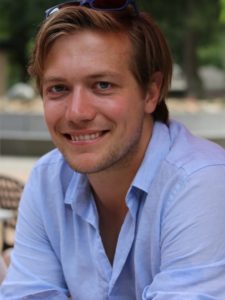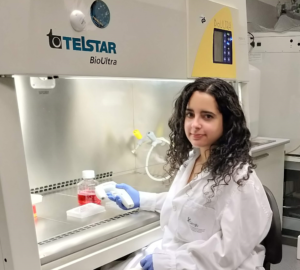Training with the NCDIR
Our Center represents an important resource of instrumentation, software, methods, and expertise that we have developed and optimized. The overarching goal of the NCDIR is to enable the widest range of researchers in the biomedical community to access our interactomics pipeline resource, and to transfer the pipeline technology to researchers’ laboratories. One major method to achieve this goal is to create a body of researchers from a wide diversity of fields who are trained in the use of NCDIR technology. These researchers will, in turn, act as nuclei to seed further spreading of our approaches in the community.
Our Center places great value in scientists training scientists and this training provides direct scientist-to-scientist training for trainees who want to learn and/or apply a tool (method, technology) to their own science. The NCDIR visiting scientist program trains scientists who desire to apply NCDIR science or technology directly to their research. Initially, to ensure quality control and standard operating procedures, this hands-on training occurs at one of the Center locations (Rockefeller University, UCSF, or Center for Infectious Diseases Research). Once the scientist is trained (i.e., knowledge transfer of NCDIR science or technology), NCDIR scientists continue to interact with the scientist remotely, or through additional direct interactions and further technology advancement at an NCDIR site or at the scientist’s home institution/lab. Thus, our cross-institutional training is one of the ways in which the expertise gained through the NCDIR is transferred to the community. Furthermore, providing training also has the added benefit of encouraging scientists to learn new techniques in a collaborative learning environment. The scientists in the Driving Biomedical Projects (DBPs) and Collaborations and Service Projects (C&SPs) also provide hands-on training for other scientists.
Since 2018 our labs have provided direct hands-on training to 93 investigators/students, including 75 scientists from 7 states in the US and 18 scientists from 5 foreign countries; representing a highly active and successful outreach of the Center through user training. The NCDIR currently has over 60 active collaborations from over 40 institutions. If you are a scientist seeking in-depth training, typically we ask that you seek to collaborate with one of our scientists, and then visit one of the labs on a longer-term basis (i.e. several months). The role of the Center in our collaborators’ work is acknowledged through listing the P41 (P41 GM109824/GM/NIGMS NIH HHS/United States) as grant support in their publications or acknowledge the fact that they got help for the NCDIR funded by the P41 grant.
Visiting scientist and reciprocal training program. Generally, to set up training with the NCDIR, community scientists contact a NCDIR scientist (including the PIs) at the institution where the training should best occur. Alternatively, NCDIR personnel reach out to scientists to inform them of the potential contributions NCDIR can make to a project. The training provided is based on the scientific challenge at-hand, and the current status of the NCDIR method or technology. Hands-on direct contact training will occur at one of the Center institutions to ensure quality control and standard operating procedures are followed. Fully equipped benches and adjacent workstations are dedicated and made available for NCDIR visiting scientists; surrounded by the interactomics equipment (cryomilling stations, 96-well solution handling and screening equipment, HPLCs and FPLCs, mass spectrometers, and computer workstations) needed to complete the training, as well as on-hand NCDIR members with the appropriate expertise. Thus, the NCDIR visiting researcher has everything they need within a few paces of their bench for being trained on taking their samples from frozen cells to multiple analytic stages. Once the research, technology, method, or software is proven to be robust within the Center, NCDIR scientists can then visit the trainee’s lab to train these scientists at their home institutions. In this way NCDIR scientists are able to provide hands-on training to teach trainees to directly apply our methods, technologies, and/or modeling to their own research.
The NCDIR Fellows Program. We have developed a Fellows program to provide trainees within the NCDIR the opportunity to receive hands-on training in a specific research, technology, method or computational tool to help further their own research. We have leveraged the framework of the Fellows program from within the NCDIR to trainees in the greater biomedical community. Our current and previous Fellows are listed below.
If you are interested in collaborating with one of our researchers, visit our About Us page to contact the four PI’s directly or contact admin@NCDIR.org!
Training with the NCDIR can also be done virtually via our video links which can be accessed here.
Visiting Student Profile
5 minutes with visiting Masters student, Lars ter Morsche
 Lars, where are you visiting from?
Lars, where are you visiting from?
I’m an MSc student from the University of Groningen/University Medical Center Groningen in the Netherlands.
What are your research interests?
Being only at the very start of my research career, those interests have started to take shape but are at the same time yet to be completely defined. The well-defined foundation for me was an interest in the molecular basis of life (and disease), which I was able to explore partly during a previous internship in molecular oncology. Having completed that I wanted my current internship to shift more towards a biochemical and protein angle. I am currently interested in studying the endogenous interactome of the LINE-1 RNP. LINE-1 (or L1) is a retrotransposon that can copy-and-paste itself into the human genome via an mRNA intermediate. This mechanism relies on the interaction of the mRNA with its two self-encoding proteins, and this self-proliferative capacity has led to the fact that over the course of evolution, LINE-1 has been able to multiply to occupy 17% (!) of the human genome today.
How did you come to learn and work with the NCDIR?
The research Master’s program that I’m enrolled in provides the opportunity to pursue a 6-months research internship in a lab of choice, after which I plan to pursue a PhD. In Groningen I met Dr. John LaCava, and together we set up this collaboration of me working under his supervision in the Rout lab.
What do you hope to learn?
Working in the Rout lab, in a world-renowned institution such as The Rockefeller University, and under the direct supervision of Dr. John LaCava provides me with a set of skills and knowledge that I will cherish for the rest of my scientific career. Coming to the Rout lab I expected an environment of distinguished researchers that could help me broaden my knowledge in the field of biochemistry and protein biology, and yet also one that would challenge me and help me develop the skills to become an independent researcher.
How has your time been so far?
The knowledge base in the lab is enormous, as is the willingness to share that knowledge. I’m also given the opportunity to independently search for the path of scientific progress, and – perhaps most importantly – learn from my mistakes. I’m confident that I will step out of the Rout lab with a solid base for starting a PhD, and I would be very glad to collaborate with the Rout lab or any of its members in the future.
Introducing our 2019 NCDIR Fellow – María Benítez Guijarro
The 2019 NCDIR fellow is Ms. Maria Benitez Guijarro, PhD candidate and member of Garcia-Perez lab, GENYO, Pfizer-University of Granada-Junta de Andalucía, Centre for Genomics and Oncological Research in Spain. Maria has spent 9 months at The Rockefeller University working within the LINE-1 research team of Dr. John LaCava. She received advanced training in protein interactomics and leveraged resources and assistance provided by Profs. Michael Rout and Brian Chait and their lab members to explore endogenous LINE-1 interactomes in embryonal carcinoma cells (PA-1).

Class-1 Long INterspersed Elements (LINE-1s or L1s) are abundant human active retrotransposons (comprise >17% of our genome) that move using a copy-and-paste mechanism, generating new insertions during early human embryogenesis which can sporadically result in the generation of new genetic disorders. Previous research from Garcia-Perez lab demonstrated that new LINE-1 insertions in Pluripotent Cells (PCs) are silenced epigenetically shortly after/during insertion, using a novel but otherwise completely uncharacterized mechanism. LINE-1 silencing only occurs in PCs, and this restriction mechanism is absent in isogenic Differentiated Cells (DCs). The main goal of Maria’s project in collaboration with the NCDIR is to discover the mechanism of LINE-1 insertion silencing in PCs, as this restriction mechanism may mitigate the mutagenic potential of LINE-1 during evolution and development. As L1s are known to impact the genomes of human embryonic stem cells, with potential in regenerative medicine, understanding how L1 is regulated is important to guarantee their safety for clinical use.
To interrogate the above-described mechanism and identify factors linked to LINE-1 insertion silencing, Maria carried out co-immunoprecipitation studies of the LINE-1 ORF1 protein and its interactors in PCs and DCs from PA-1 cells. For this she worked together with other NCDIR scientists, including Ms. Hua Jiang, Ms. Kelly Molloy, and Dr. Mehrnoosh Oghbaie, to capture LINE-1 ribonucleoprotein particles and conduct mass spectrometry-based protein interaction studies on them. As a result of this work, they identified a list of factors that will be subsequently validated by Maria using CRISPR/Cas9 genome editing and retrotransposition activity assays. During her visit, Maria also worked to develop a ‘capillary western’ (Protein Simple: simple western) assay for the combined detection of ORF1p and ORF2p, the two proteins encoded by LINE-1. Her aim is to easily facilitate future, rapid quantitation of LINE-1 proteins across different samples.
Maria Benitez Guijarro’s visit was funded by an EMBO short-term fellowship and the Fellowship for temporary transfers for FPU from the Spanish Government.
Collaborator profile
5 minutes with visiting Research Assistant Professor, Adnan Halim, PhD

Adnan, where are you visiting from?
I’m visiting from the Copenhagen Center for Glycomics, Department of Cellular and Molecular Medicine, Copenhagen University
What are your research interests?
I’m interested in the regulation and functions of O-linked mannose (O-Man) glycosylations in eukaryotes. This post-translational modification (PTM) is conserved throughout evolution and servers essential cellular functions in organisms ranging from yeast to humans. However, identification of O-Man proteins and their modified sites remains technically challenging, and these limitations hamper our ability to fully understand the cellular functions of O-Man glycosylations. My research involves the use of advanced mass spectrometry to study structures, map site-specific locations and quantify changes of protein O-Man glycosylations on a proteome-wide scale.
Why have you come here to collaborate with the NCDIR in NYC?
We (my lab) recently described a new type of O-Man glycosylation found on yeast nucleocytoplasmic proteins (e.g. nucleoporins) and our hypothesis suggests that this PTM is involved in a myriad of cellular processes, mirroring the signaling- and regulatory functions of the mammalian O-GlcNAc system. We aim to explore the functions and regulations of these O-Man glycosylations, including their cross-talk with other PTMs (e.g. phosphorylation), using the yeast nuclear pore complex (NPC) as a model system.
The Rout lab is world-renowned for their pioneering structural work on the yeast NPC and their innovative interactomics platform. My visit in the Rout lab allows me to acquire key knowledge and skills in the field of interactomics. I am currently undergoing rigorous training and learning how to apply state-of-the-art methods/tools in my research related to O-Man glycosylation and the yeast NPC. The training-through-research approach is supervised by Prof. Michael P. Rout and Dr. Javier Fernandez Martinez and supported by all lab members. My long-term goal is to integrate interactomics with our main research activities focused on O-Man glycosylations upon my return to Copenhagen. We envision that this unique combination of techniques will enable major breakthroughs in mass spectrometry-based glycoproteomics and glycobiology.
Thanks Adnan! All the best for your research endeavors!
